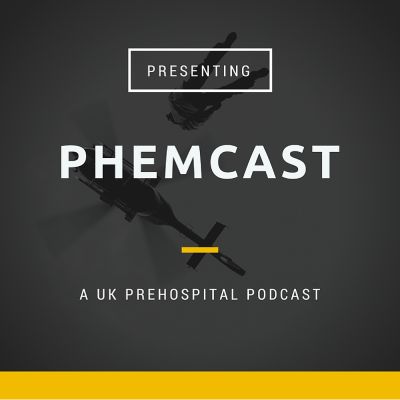A UK Prehospital Emergency Medicine Podcast. This podcast and associated website aims to: - Share knowledge and expertise in the field of prehospital medicine with specific reference to the UK working environment - Make this content relevant to all professional prehospital practitioners
https://phemcast.co.uk
Episode 5: Amputation
https://phemcast.files.wordpress.com/2016/02/amputation.mp3
Welcome to PHEMCAST episode 5: Amputation
One of the things we never want to have to do, but need to be prepared for. Have a listen, consider your kit, your top-cover arrangements, and when and how you may need to get this done.
This podcast covers, which patients to consider, how to do it and discussion around consent, capacity and top-cover arrangements.
This podcast features interviews with Professor Sir Keith Porter and Caroline Leech, which we hope you will enjoy.
Which patients / scenarios:
- An immediate and real risk to the patient’s life due to a scene safety emergency.
- A deteriorating patient physically trapped by a limb when they will almost certainly die during the time taken to secure extrication
- A completely mutilated non-survivable limb retaining minimal attachment, which is delaying extrication and evacuation from the scene in a non-immediate life-threatening situation.
- The patient is dead and their limbs are blocking access to potentially live casualties.
Which kit:
- CAT x 2
- Scalpel
- Gigli saw (and spare)
- Arterial forceps x 4
- Tuff Cut scissors
- Appropriate dressing (e.g. Israeli combat bandage)
Preparation:
- Sedation or anaesthesia
- Brief team
- Plan next phase
Stages of amputation process:
- Apply an effective proximal tourniquet.
- Amputate as distally as possible.
- Perform a guillotine amputation.
- Apply haemostats to large blood vessels.
- Leave the tourniquet in situ.
(consider IV antibiotics if can be delivered as concurrent activity)
Please contribute to the blog below – specifically around top cover arrangements, decision making and individual competency around this procedure.
References:
Porter KM. Prehospital amputation. Emerg Med J. 2010 Dec 1;27(12):940–2.
Reid C, Clancy M. Life, limb and sight-saving procedures–the challenge of competence in the face of rarity. Emerg Med J. 2013 Feb 1;30(2):89–90. .
Porter K. Ketamine in prehospital care. Emerg Med J. 2004 May 1;21(3):351–
Brodie S, Hodgetts TJ, Ollerton J, McLeod J, Lambert P, Mahoney P. Tourniquet use in combat trauma: UK military experience. J R Army Med Corps. 2007 Dec 1;153(4):310–3.
Akporehwe NA, Wilkinson PR, Quibell R, Akporehwe KA. Ketamine: a misunderstood analgesic? BMJ. 2006 Jun 24;332(7556):1466.
McNicholas MJ, Robinson SJ, Polyzois I, Dunbar I, Payne AP, Forrest M. ‘Time critical’ rapid amputation using fire service hydraulic cutting equipment. Injury. 2011; 42: 1333-1335.
